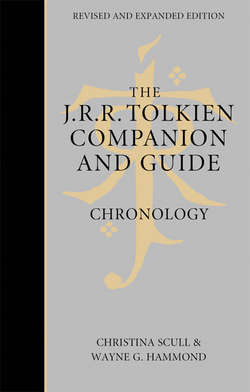Читать книгу The J. R. R. Tolkien Companion and Guide: Volume 1: Chronology - Christina Scull - Страница 18
Оглавление1896
January 1896 Mabel hears that Arthur is still in poor health, and decides that she must return to Bloemfontein to take care of him. She books passage to South Africa for herself and the boys, to leave on 2 March.
14 February 1896 Ronald dictates to his nurse a letter to his father: ‘I am so glad I am coming back to see you it is such a long time since we came away from you…. I am got such a big man now because I have got a man’s coat and a man’s bodice…. Auntie Gracie [Grace Mountain née Tolkien] has been to see us I walk every day and only ride in my mailcart a little bit’ (quoted in Biography, p. 16). On that same day Mabel receives a telegram that Arthur has suffered a severe haemorrhage. Ronald’s letter is never sent.
15 February 1896 Arthur Tolkien dies in the afternoon. See note. The funeral service is held in the Cathedral in Bloemfontein, and he is buried in the Anglican cemetery. Arthur’s estate will bring Mabel an income of only some thirty shillings per week, from shares in South African mines; to this Walter Incledon will add a little. She and the boys are unable to stay in the Suffield house permanently, and in any case Mabel thinks that country air will benefit her sons.
Summer 1896 Mabel Tolkien rents a cottage at 5 Gracewell Road in *Sarehole, a hamlet south of Birmingham. At the impressionable age of four and a half, for the first time Ronald experiences life in a green countryside. He and Hilary explore the surrounding area: Sarehole mill with its water-wheel, meadows, and a tree-lined sandpit; they paddle in the stream; they pick wildflowers and mushrooms and gather blackberries, and are sometimes chased by irate millers or farmers when they trespass. They also climb trees, including a willow which overhangs the mill pond; Ronald will not forget that one day this tree was cut down and simply left lying on the ground. He and Hilary make friends with some of the local children and learn a little of the local dialect, but are sometimes mocked for their middle-class accents, long hair, and pinafores.
1 August 1896 John Benjamin Tolkien dies.
1896–1899 Mabel decides to teach her boys at home. Ronald had already learned to read by the age of four. He now develops a decorative style of handwriting indebted to his mother’s own, and an abiding interest in alphabets and scripts (*Calligraphy). He also begins to learn Latin and German, which he likes, and French which attracts him less. When he shows an aptitude for *languages, and an interest in the sounds, shapes, and meanings of words, his mother also begins to teach him etymology, in which she herself is interested. She tries to teach him to play the piano but has little success. He is more interested in drawing, especially landscapes and trees. He will develop a great interest in botany and come to know the subject well.
The only subject that Mabel does not teach him is geometry; this is taught by his Aunt Jane, Mabel’s sister. Ronald will later say that it was ‘to my mother who taught me (until I obtained a scholarship at the ancient Grammar School in Birmingham) that I owe my tastes for philology, especially of Germanic languages, and for romance’ (Letters, p. 218). He will also remark, of early interests that remained with him through the years: ‘It has always been with me: the sensibility to linguistic pattern which affects me emotionally like colour or music; and the passionate love of growing things; and the deep response to legends (for lack of a better word) that have what I would call the North-western temper and temperature’ (letter to W.H. Auden, 7 June 1955, Letters, p. 212).
It is probably in this period that Mabel takes the boys on at least one seaside holiday, and Ronald begins his first sketchbook: near the beginning is a childish drawing, Sea Weeds and Star Fishes (Life and Legend, pp. 12–13). – At this time Mabel is still a practising Anglican. Since her husband’s death, she has taken her sons with her every Sunday to a ‘high’ Anglican Church.
Ronald’s early reading includes the Alice books by Lewis Carroll, which amuse him; The Princess and the Goblin and The Princess and Curdie by *George MacDonald; the fairy books of *Andrew Lang, in particular ‘The Story of Sigurd’ in The Red Fairy Book which fires his interest in *dragons; and Stories for my Children by E.H. Knatchbull-Hugessen, especially the tale of ‘Puss Cat Mew’ (*Fairy-stories). He also likes Red Indian tales and Arthurian legends (*Arthur and the Matter of Britain). In later life, he will note that he did not enjoy Treasure Island by Robert Louis Stevenson, the stories of Hans Christian Andersen, or The Pied Piper by Robert Browning; and that while he read fairy-stories he did not develop a real taste for and appreciation of them until he was about eight. Nor was it until he began to study Latin and Greek at school that he developed any appreciation of *poetry. Even in early childhood his interests are more factual or scientific (*Science): history, astronomy, natural history (especially botany and zoology), palaeontology (he liked pictures of prehistoric animals), geology, grammar, and etymology. He will note several times that he was not particularly interested in or proficient at mathematics.
1896–1900 Much later, Tolkien will write to a group of primary school children in *Acocks Green, some two miles north-east of Sarehole: ‘I lived till I was 8 at Sarehole and used to walk to A[cocks] G[reen] to see my uncle. It was all “country” then …’ (17 October 1966, quoted in Sotheby’s, English Literature, History, Children’s Books and Illustrations, London, 16 December 2004, p. 274).
